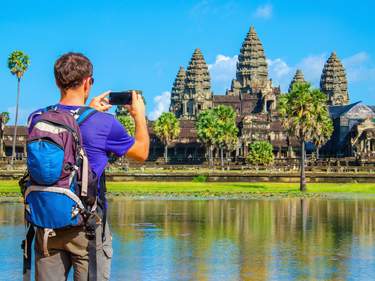Bayon temple - visit over lunch
The Bayon, with its pyramid covered in hundreds of half-smiling faces, is busy with visitors almost all day long. It seems to magnetically pull the very worst of the shuffling crowds to its giant stone terraces.
Fortunately, most visitors appreciate a good long lunch. Between about twelve and two in the afternoon you may be able to get the fascinating faces to yourself for a minute or two. Don’t forget your sun cream and a hat – there’s very little shade.
Ta Prohm - see it at sunset
Ta Prohm, which featured in Tomb Raider, is a contrast – its shady jungle-cloaked ruins are most popular during the hottest part of the day. For Ta Prohm, dusk the perfect time to visit, as everyone else heads en masse to Phnom Bakheng hill to see the sunset. Wait behind and you should have almost no competition for the perfect photograph at this most atmospheric temple.
How much time do I need to explore the temples?
One of the best ways to enjoy Angkor Wat without the crowds is to explore beyond the most popular sites. The site spans around 400 square kilometres, so you'll have plenty of options. The 'big three' will take a full day to see properly – so plan on getting a three-day ticket. This will give you time to step away from the hordes and see some of the temples you won’t have heard of.
Ta Keo is within selfie stick swinging distance of Ta Phrom but it wasn’t in Tomb Raider and so it is not on most visitors’ itineraries. Even better, the temple steps are seriously steep, making the climb hard enough to put off most people. The result? A view over the temple-dotted landscape from 21 metres up, and away from everyone else.
Already planning a trip to Cambodia? Find even more useful information in our tips for visiting Cambodia.



















